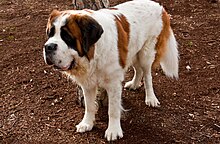St. Bernard
The St. Bernard is a breed of very large working dog from the Italian and Swiss Alps, originally bred for rescue. The breed has become famous through tales of alpine rescues, as well as for its enormous size.
Appearance
The St. Bernard is a giant dog. The average weight of the breed is between 140 and 264 lb (64–120 kg) or more and the approximate height at the withers is 27½ inches to 35½ inches (70 to 90 cm). The coat can be either smooth or rough, with the smooth coat close and flat. The rough coat is dense but flat, and more profuse around the neck and legs. The coat is typically a red color with white, or sometimes a mahogany brindle with white. Black shading is usually found on the face and ears. The tail is long and heavy, hanging low eyes should have naturally tight lids, with "haws only slightly visible". The eyes are usually brown, but sometimes can be icy blue.
History
The ancestors of the St. Bernard share a history with the Sennenhunds, also called Swiss Mountain Dogs or Swiss Cattle Dogs, the large farm dogs of the farmers and dairymen of the livestock guardians, herding dogs, and draft dogs as well as hunting dogs, search and rescue dogs, and watchdogs. These dogs are thought to be descendants of molosser type dogs brought into the Alps by the ancient Romans, and the St. Bernard is recognized internationally today as one of the Molossoid breeds.
The earliest written records of the St. Bernard breed are from monks at the hospice at the Great St Bernard Pass in 1707, with paintings and drawings of the dog dating even earlier.
The most famous St. Bernard to save people at the pass was Barry (sometimes spelled Berry), who reportedly saved somewhere between 40 and 100 lives. There is a monument to Barry in the Cimetière des Chiens, and his body was preserved in the Natural History Museum in Berne.
The classic St. Bernard looked very different from the St. Bernard of today because of cross-breeding. Severe winters from 1816 to 1818 led to increased numbers of avalanches, killing many of the dogs used for breeding while they were performing rescues.[5][6] In an attempt to preserve the breed, the remaining St. Bernards were crossed with Newfoundlands brought from the Colony of Newfoundland in the 1850s, and so lost much of their use as rescue dogs in the snowy climate of the alps because the long fur they inherited would freeze and weigh them down.
The dogs never received any special training from the monks. Instead, younger dogs would learn how to perform search and rescue operations from older dogs.
The Swiss St. Bernard Club was founded in Basel on March 15, 1884. The St. Bernard was the very first breed entered into the Swiss Stud Book in 1884, and the breed standard was finally approved in 1888. Since then, the breed has been a Swiss national dog.
Naming
The name "St. Bernard" originates from the Great St Bernard Hospice, a traveler's hospice on the often treacherous St. Bernard Pass in the Western Alps between Switzerland and Italy. The pass, the lodge, and the dogs are named for Bernard of Menthon, the 11th century monk who established the station.
"St. Bernard" wasn't in widespread use until the middle of the 19th century. The dogs were called "Saint Dogs", "Noble Steeds", "Alpenmastiff", or "Barry Dogs" before that time.
 | ||||
| St. Bernard | ||||
| Other names | St. Bernhardshund Bernhardiner Alpine Mastiff (archaic) | |||
|---|---|---|---|---|
| Nicknames | Saint | |||
| Country of origin | Italy / Switzerland | |||
| ||||
| ||||


No comments:
Post a Comment